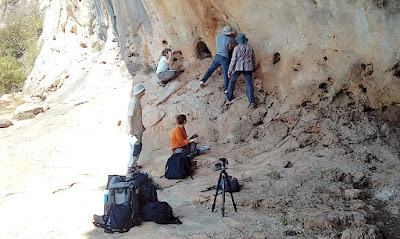South America:
First of all, it should be noted that in the area of Andean South America, numerous bones of horses and other animals have been found in tar seeps and tar pits, the latter like those of La Brea, California. Equus horse bones have been found in a tar seep location that preserved a dense assemblage of megafaunal remains in hydrocarbon-saturated sediments along with microfaunal and paleobotanical material, that has a claimed date between 15000 and 21000 BC.
Ecuadorian Tar Pits where numerous animal remains have been found throughout Ecuador
Other locations where these bones have been found is in the Inter-Andean Basin, Quito, Bolivar, Corralito, and the Carchi Province; as well as others in Peru. One of the latter is that of Talara, about 40 miles northwest of Piura, along the coast where a tar trap contained a fossil horse jaw, along with 28,000 bones, including elephants, horses and carnivores (K. Seymour, Perusing Talara; Overview of the Late Pleistocene fossils from the tar seeps of Peru,” Natural History Museum of Los Angeles County, Science Series, Vol.42, 2015, pp97-109).
While it is true that the dates involved are about the end of the Ice Age, it should be kept in mind that there were no ice sheets in South America during the Last Glacial Maximum north of Chilean Patagonia. There was ice along the peaks of the Andes in Peru, but the area of the above tar pit and seeps were located along the coast, which during the Last Ice Age was considered “Tropical Desert” or “Tropical Grassland” or “Temperate Steppe Grassland.” The point being, there would have been no reason for any horses in western South America to have become extinct as in the far north of North America where the glaciers were located. Thus this concept of Equus horse becoming extinct throughout South America, even Central America and Mexico to the Central Plains of North America, is hardly valid.
In addition, and more to the point of the time period between the Ice Age and the arrival of the Spanish, Sebastian Cabot (Sebastiano Caboto or Gaboto) son of Venetian navigator and explorer John Cabot (Giovanni Caboto) whose 1497 discovery of the coast of North America under the commission of Henry VIII of England, brings us a knowledge of horses in South America during the recent age of man. While his father’s discovery was the first European exploration of coastal North America since the Norse visits to Vinland in the eleventh century, Sebastian, who was with his father in North America, mounted his own explorations of South America.
Left: John Cabot in traditional Venetian clothing, discovering the
Canadian east coast of North America in 1497; Right: Sebastian Cabot, son of
John, and navigator and cartographer who sailed to South America in 1526 along
the Argentina coast and upriver on the Rio de la Plata; and the Paraná River
into Uruguay
Sebastian Cabot’s 1533 drawing on his "Tabula del gran río" map of the horse, a jaguar, and a parrot accurately drawn along the Paraná River
Sir Edwin Ray Lankester, who was a British authority on zoology, and who held chairs at Cambridge and Oxford Universities, wrote in a book published in 1910: “It is also said that the Araucanian Indians of Patagonia have a peculiar breed of ponies, which may be derived in part from a native South American stock” (Sir Edwin Ray Lankester, Science from an Easy Chair, Methuen, London, 1910—there have been 59 editions of this book published between 1910 and 2013).
It should also be noted that the existence of ancient, indigenous horses on the American continent was only first accepted in 1848, when Richard Owen described a fossil horse from South America. The first scientific paper on ancient horses in the Americas was published that same year by American paleontologist, parasitologist and anatomist Joseph Leidy, professor of anatomy at the University of Pennsylvania and later professor of natural history at Swarthmore College.
However, horse fossils, bones, and teeth have now been found in North, Central, and South America. Unfortunately for this solution for the Book of Mormon, however, mainstream scholars typically see such theories as unworthy fringe writing and claims among questionable writers. Due to the lack of acceptance through archaeological support of numerous well-founded and well-carried out efforts in the Americas, most scholars continue to believe that horses became extinct at the end of the Pleistocene period.
A
group of archaeologists using ArchaeChemis equipment involved in Archaeology
and Archaeometry studies, which include chemical solitons in Archaeometry
While this blog is not trying to vindicate or promote Dr. Jones’ work, we certainly feel his credentials deserve to be considered and understood in light of the questions about his horse research and claims in the Americas. We are certainly not suggesting there is any conspiracy afoot as many do, we are merely stating that mainstream science has to be reevaluated and changed from time to time as new evidences, new knowledge, and new findings become available and are accepted by mainstream scientists. It should be noted that thoseon the cutting edge and at the forefront of such advanced knowledge are often shunned by mainstream thinking until such thinking is accepted ny those in the mainstream. Dr. Jones may well be ahead of this mainstream curve.
(See the next post, “Where Are the Land of Promise Horses? – Part VII,” for more information about horses in the Americas and specifically in South America)








Excellent article Del!
ReplyDeleteI also believe that Steve Jones is ahead of the curve in the physics that prove the three towers fell by controlled demolitions on 9/11, and not by brief explosions and fire caused by the 2 planes.
ON THE PHYSICS OF HIGH-RISE BUILDING COLLAPSES